The Complete Guide to Law Firm Retainer Fees
What is Retainer Fee For a Lawyer?
In simple terms, a law firm retainer is an upfront payment for future legal services. Funds are typically placed in a trust account, keeping the client’s money away from the firm’s operating expenses.
What Are The Benefits of Retainer Fees For Lawyers (and Clients)
Here’s a quick rundown of the benefits of retainer fees for both law firms and your clients:
- Better cash flow management — Make it easier to manage and plan your finances by guaranteeing income.
- Avoid the hassle of non-payment — Getting paid in advance ensures you save yourself from the risk of non-payment and writing debt collection letters.
- Improve client relationships — Retainers give you the opportunity to showcase your firm’s dependability while making financial transactions more convenient and streamlined.
- On-demand legal support — For clients, paying retainers earns them the privilege to seek legal advice, guidance, and services without going through the usual, time-consuming process.
Components of a Lawyer Retainer Fee
A retainer fee for lawyers usually includes these components:
- Initial deposit — The initial upfront sum the client pays to secure the law firm’s services.
- Scope of work — A clear outline of the legal services that the lawyer will perform (including the work timeline).
- Payment terms — Lays out terms like payment schedule and structure.
- Termination — Mentions options and grounds for the agreement’s termination (by either the client or the firm).
- Communication — Defines the frequency, channels, and terms of attorney-client communication.
- Other clauses — Includes attorney-client confidentiality, governing law, dispute resolution, and so on.
How Does a Retainer Fee Work?
Lawyer retainer fees are usually paid upfront or through a trust or escrow account, which means it’s not officially the firm’s money until it is matched with work performed.
That means the firm has no way of accessing or using the funds to cover operational expenses unless legal services are delivered. In other words, these retainer fees are still considered “unearned.”
For example, let’s say the client pays $2,000 for the retainer fee upfront. The firm then accepts the funds and deposits them into an escrow account.
Throughout the timeline, the lawyer successfully completes $1,500 worth of legal services, and then creates an invoice to withdraw the amount from the account upon the client’s approval. From there, the retainer fees are considered “earned.”
The remaining $500 may or may not be refunded, depending on the signed retainer agreement.
In some retainer agreements, the firm may enforce a minimum balance that must be topped up before any further legal work is performed.
This offers financial protection for the firm with more complex cases. At the same time, it ensures full commitment from both the firm and the client.
Just keep in mind that retainer amounts aren’t necessarily the same as the final bill amount.
In most retainer agreements, clients are charged extra for additional costs related to their case, like third-party services, delivery fees, and travel expenses.
What is a Typical Retainer Fee For a Lawyer?
In law firm billing, the typical retainer fee is between $1,000 and $5,000—depending on a handful of factors like:
- Experience
- Location
- Scope of the work
- Case complexity
The traditional retainer fee structure for legal services is the security retainer. This requires unearned legal retainer fees to be deposited into trust accounts, keeping them off the firm’s hands until they’re earned through the agreed-upon legal work.
Types of Retainer Fees
Apart from the security retainer, here are other types of retainers for legal services:
- General Retainer — This is a non-refundable retainer agreement wherein the client pays for the lawyer’s availability for a certain case or timeframe, regardless of the actual legal services rendered.
- Evergreen Retainer — A type of retainer for ongoing legal cases, requiring clients to maintain a minimum balance in the trust account (in addition to paying for additional expenses incurred).
- Hourly Rate Retainer — In this specific retainer type, the lawyer is eligible to obtain funds based on their hourly rate.
Retainer Fee Payment Models: Advanced Payment, Instalment, and Subscriptions
In terms of payment, lawyer retainer fees can be settled in multiple ways.
The top three retainer fee payment models are:
- Advanced Payment — In this model, retainer fees are paid upfront in full.
- Installments — As opposed to full upfront payments, going the installment route gives clients the ability to make smaller payments over a set schedule.
- Subscription — This type of retainer payment model involves recurring payments to replenish the account’s balance.
Also, remember that some states may define retainer fees differently.
For example, a lot of states like California use retainer fees and initial deposits interchangeably. That means all payments made toward the retainer agreement go to the client’s balance.
Other states, like Florida, however, allow non-refundable retainers to be used only as “entry fees.” While these fees do reserve the lawyer’s time and availability, they’re not considered deposits that can cover future legal services.
Some states, like New York, New Jersey, and North Carolina, also allow retainer fees to be directly deposited into the lawyer’s operating account. As such, the funds are already considered “earned” upon agreement and payment to the retainer.
Just remember that law firms across all states should observe the ethical guidelines laid out by the American Bar Association, or ABA.
Some of the key points to remember from the ABA recommendations are as follows:
- Fees must, under all circumstances, be reasonable and clearly communicated to the client.
- Unless expressly consented to by the client, unused balances or prepaid fees should be refunded to the client.
- Refundable amounts and their conditions should also be transparently described within the retainer agreement.
How to Draft a Compelling Retainer Agreement
When creating a retainer agreement, the most important rule is to be as comprehensive as possible.
Every element of your retainer agreement must be a stepping stone that will bring clients closer to fully understanding your arrangement. Be straight to the point, clear, and respectful by avoiding unnecessary legal jargon that will only take you further from your goal.
1. Start With a Title and The Parties Involved
Begin drafting your retainer agreement with a title and the names of both parties.
Go for something clear and easy to remember, like “Legal Services Retainer Agreement” or “Agreement to Employ Attorney.”
For the sake of this guide, we’ll take a look at the sample agreement by the Willick Law Group:
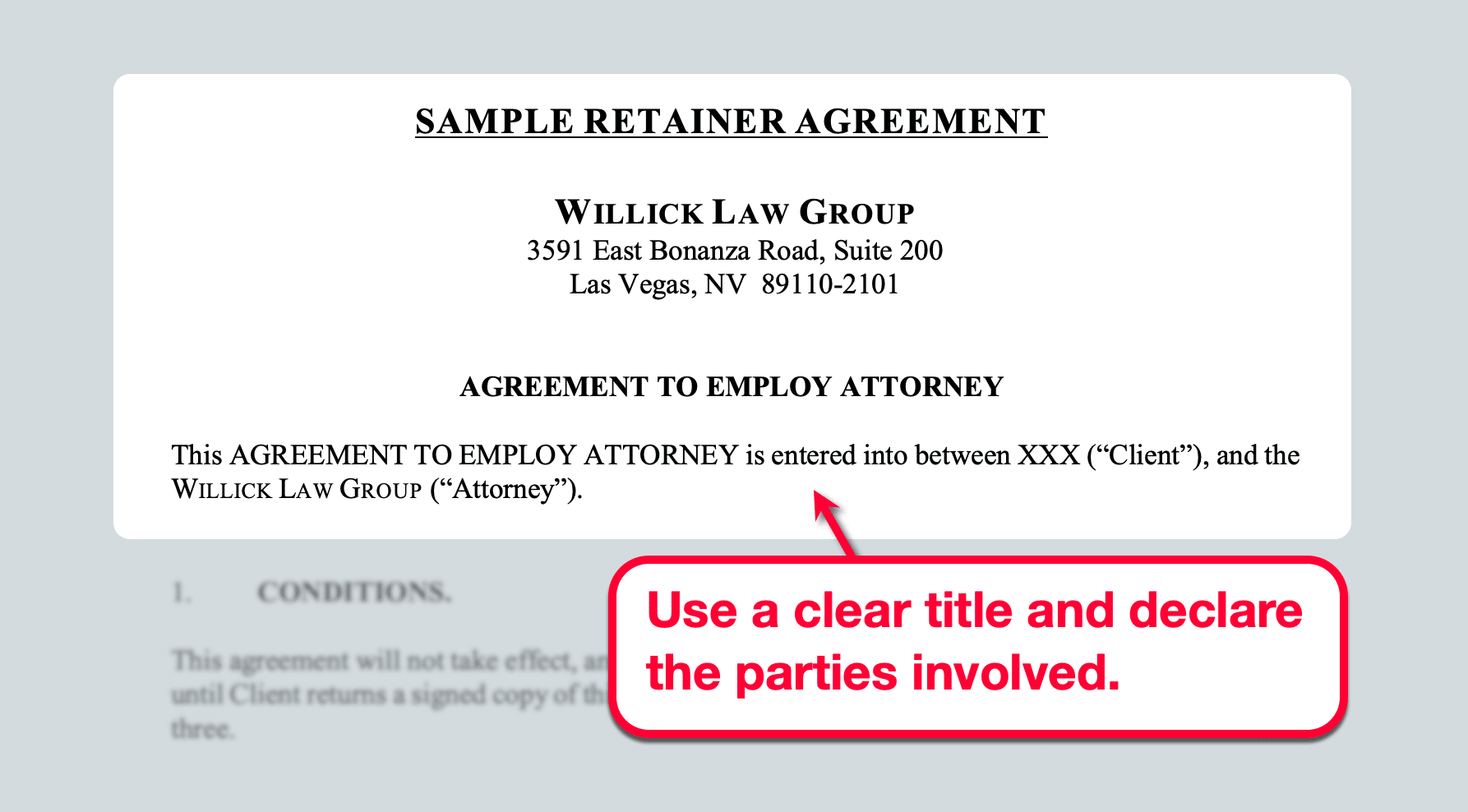
2. Define Conditions and Scope of Work
Jump straight to the conditions of the retainer agreement as well as the scope of services you’ll provide.
The key here is to immediately set the client’s expectations straight. As such, be sure to mention which legal tasks are included and excluded from your agreement.
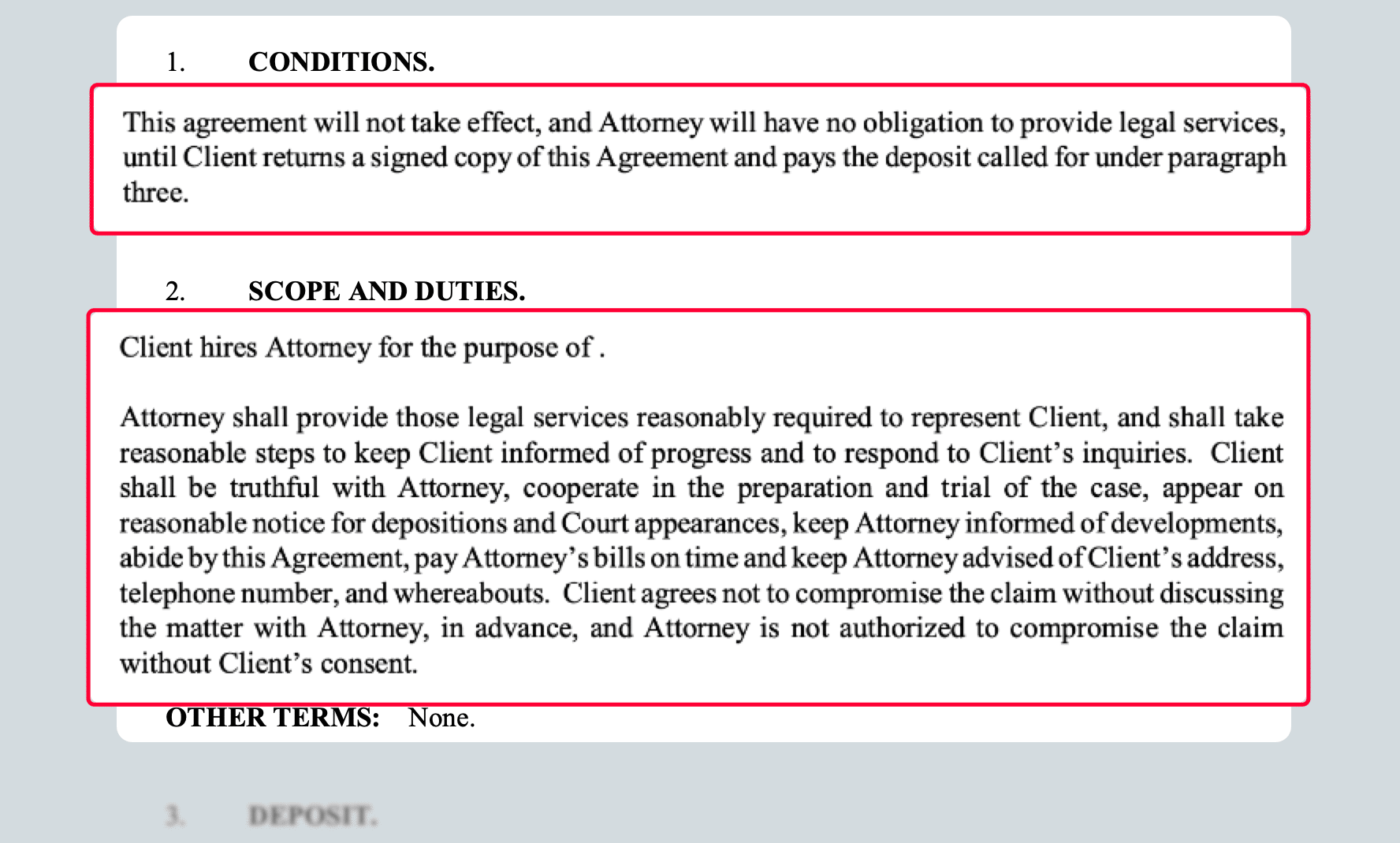
3. Discuss How Retainer Payments Work
The next section of the retainer agreement ensures there will be no misunderstandings when it comes to payments.
Discuss the type of retainer to be used, where the money will go, how the funds will be used, and if the client is required to replenish the account. Don’t forget to include clear refund policies to give clients peace of mind.
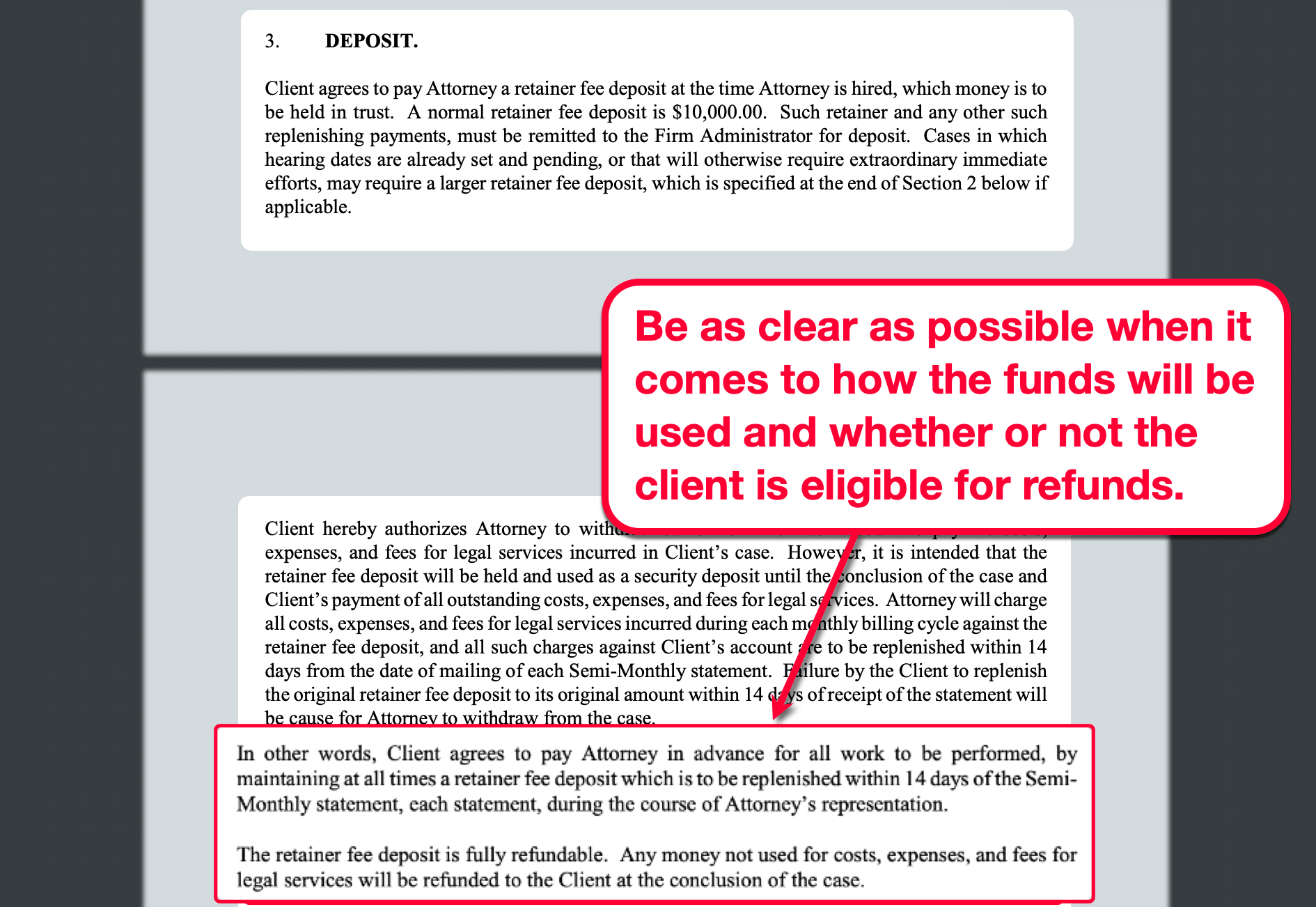
4. Establish Communication Protocols
It’s also important to discuss the means of communication that will be used while the agreement is in force.
Ideally, you should have a dedicated section in your retainer agreement highlighting how, when, and why clients can reach out to the firm. This is also a great place to lay down ground rules, like what to do with written communications and the confidentiality of communication.
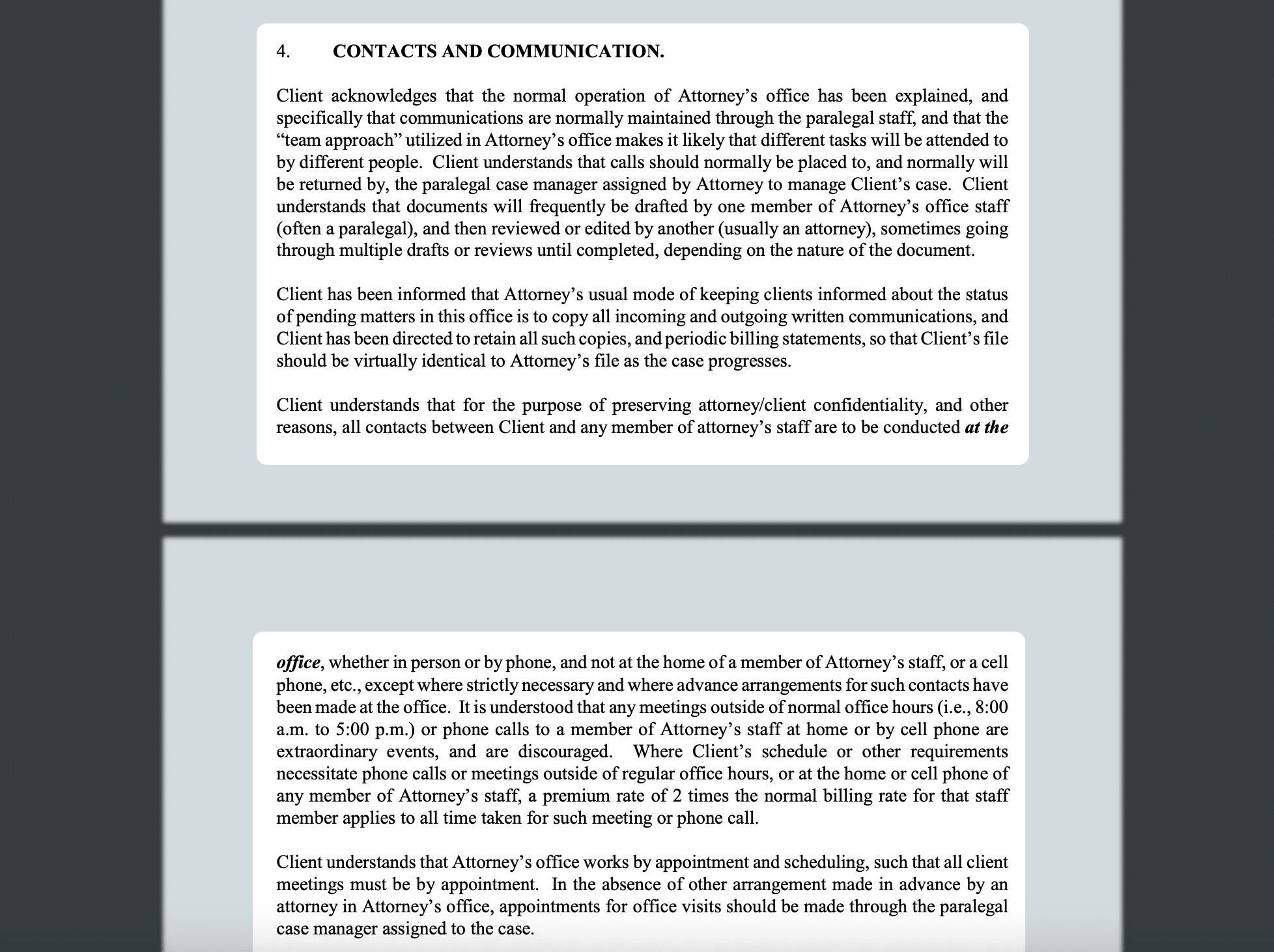
5. Break Down the Legal Fees
The legal fees section is one of the most important sections of a retainer agreement.
At this point, the client already understands how to make payments. This time, you need to be transparent on how you’ll “earn” their funds.
What you’ll write depends on the type of retainer you want to use. For instance, if you want to use an hourly rate retainer, you should start with the hourly rates that will be covered by the client’s balance.

Be sure to include any additional costs the client might incur during their time with your firm.
This may include a small entry fee, travel expenses, penalties (i.e., returned check fee), and third-party services.
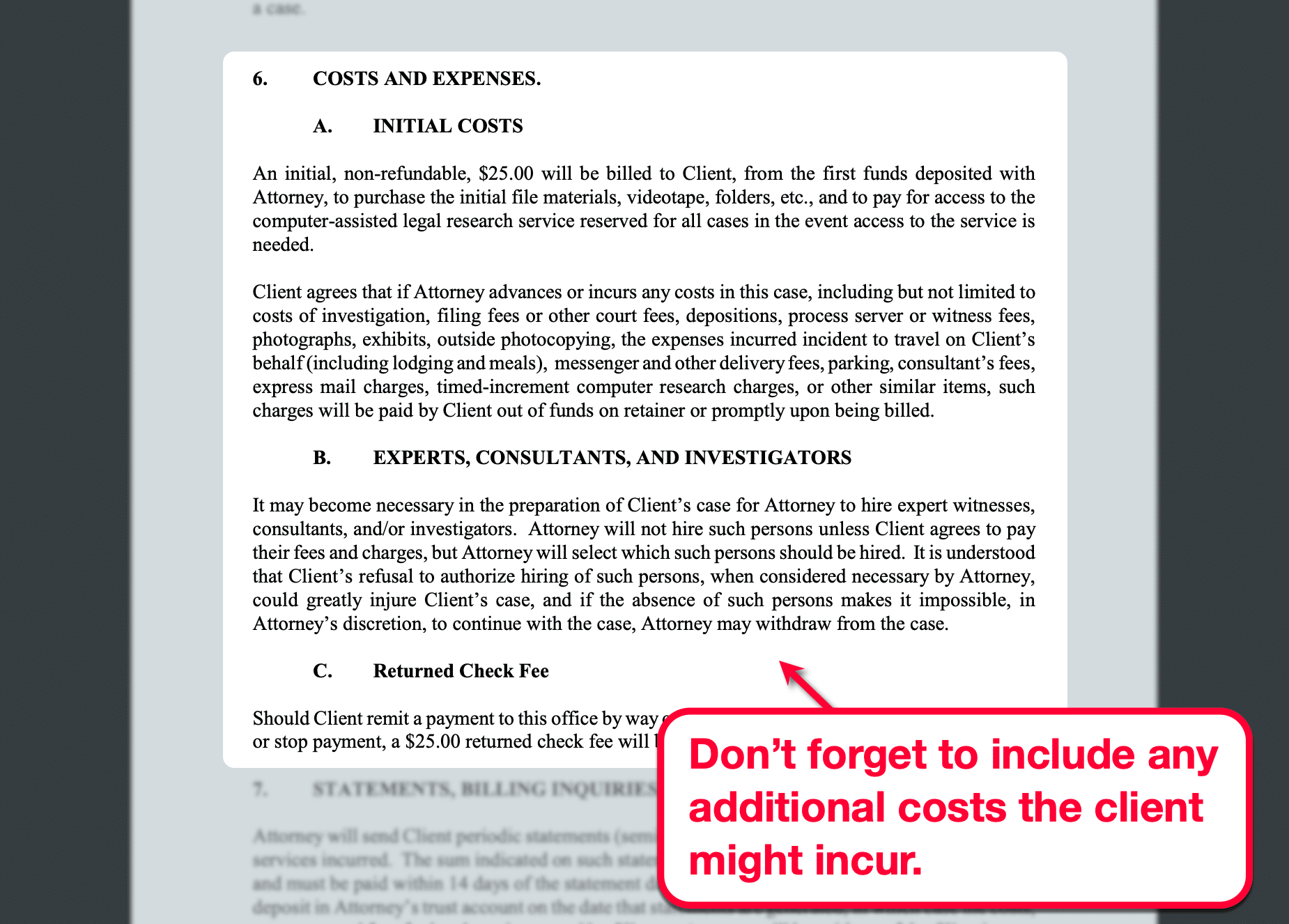
You can streamline future transactions by including a section about the client’s capacity to question or challenge charges that may be incorrect. Just be sure to protect your firm from potential exploits with clear guidelines for disputes, such as the allowed timeframe for billing-related queries.
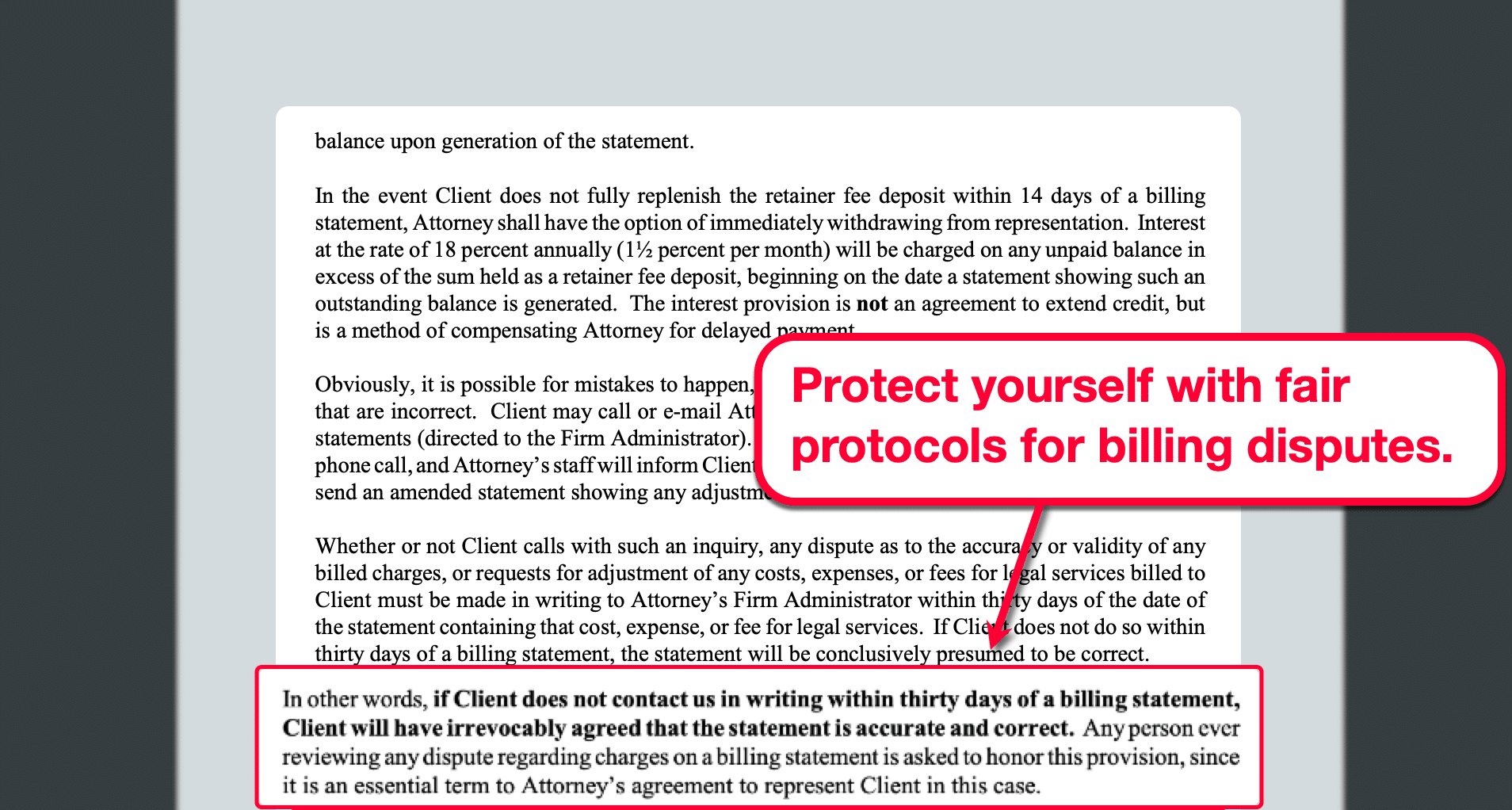
6. Include Withdrawal & Termination Clauses
Outlining conditions for ending the agreement early offers financial security to lawyers and peace of mind to clients.
You should keep this section direct and concise. Just be sure to cover the implications of early termination and the client’s obligations.
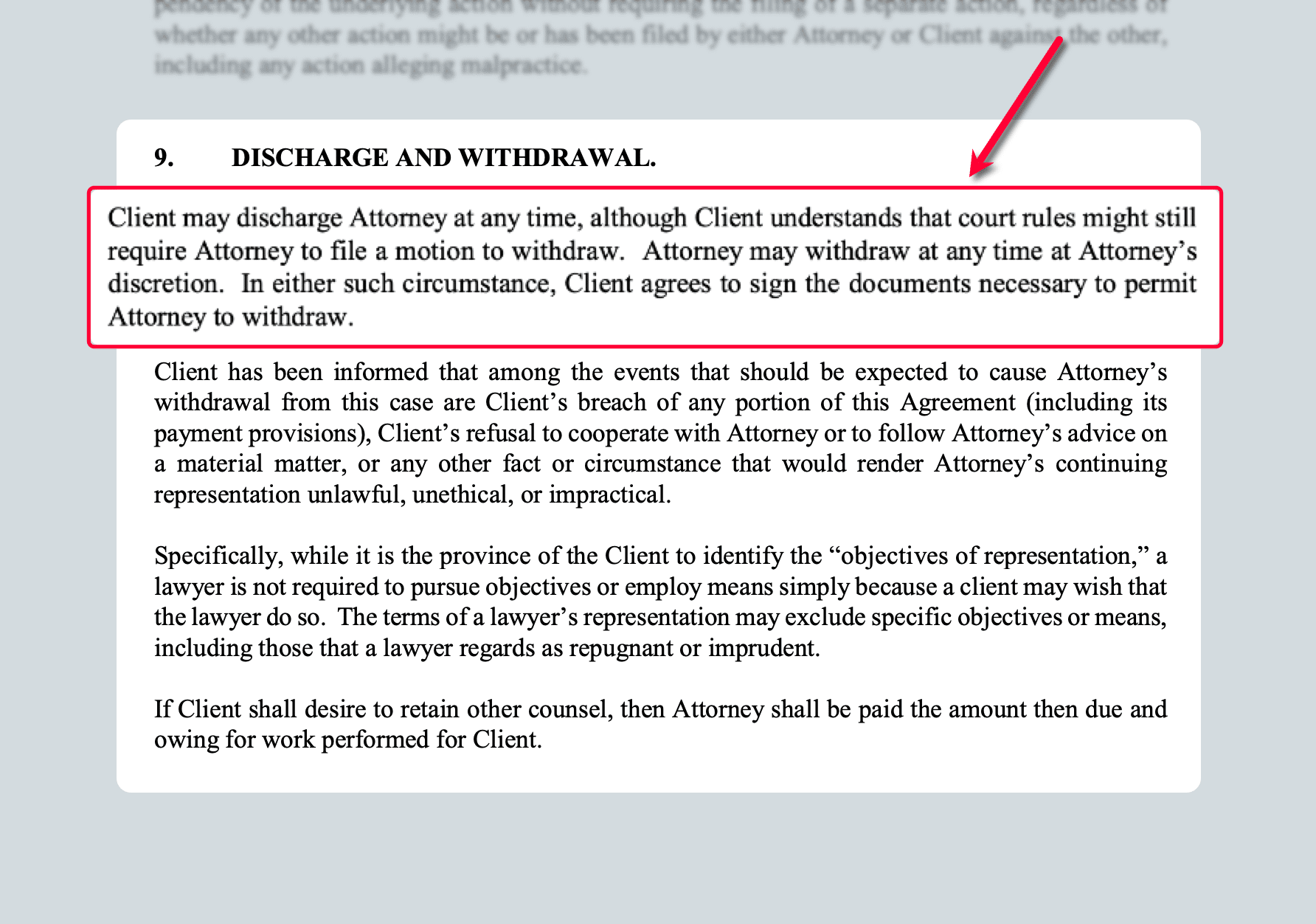
7. Signatures
The last and probably most important part of a retainer agreement is the signature block.
Make sure to remind the client to read the agreement carefully and what their signature would mean.
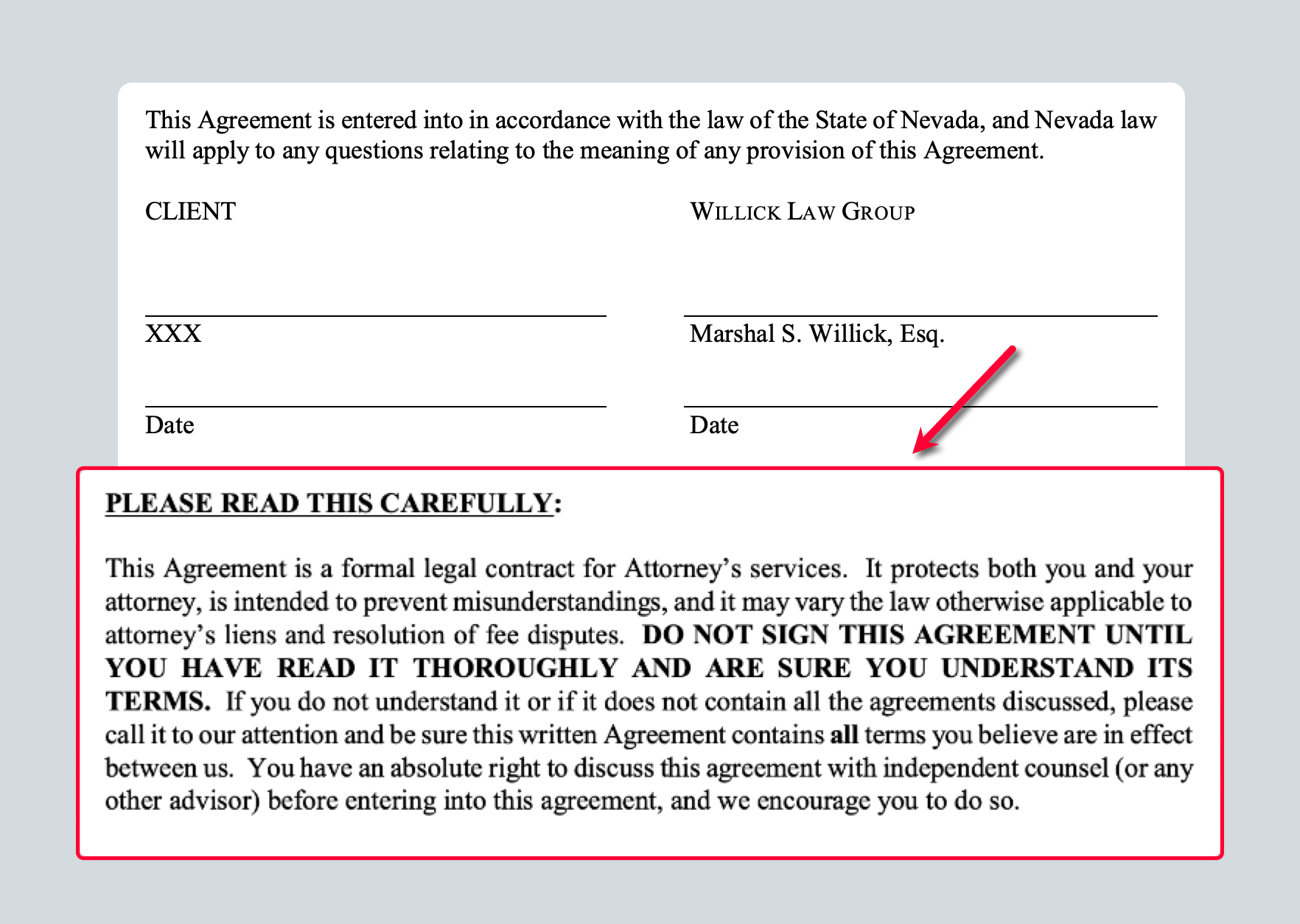
5 Best Practices For Law Firm Retainer Fees
Before we end this guide, we asked seasoned attorneys how to determine the ideal retainer fee structures to use.
Here’s what they have to say:
1. Consider Unbundling Legal Services
Structuring retainer agreements around unbundled legal services makes it easier for clients to afford the specific help they need. It also raises the perceived value of bundled services, especially if you can calculate a discounted rate that works best for everyone.
Mathew Kerbis, founder of the Subscription Attorney, shares how he experimented with pricing for his subscription-based model:

I experimented with pricing, and a major unlock for my model was first unbundling and assigning a fixed or recurring rate for all of my services (legal and legal-adjacent), then bundling them back together at a discount to sell the value of higher monthly subscriptions.
All my pricing is on my website, and my clients are not afraid to call me since doing so only means they are using what they have already paid for.

Unbundling legal services also prevents scope creep when taking on retainers. This pertains to the unplanned expansion of the scope of work due to poor planning, lack of communication, and unclear expectations.
2. Factor In Case Complexity
We can’t stress enough the importance of factoring in case complexity when deciding your retainer fees.
That’s why you don’t want a blanket retainer pricing strategy for multiple clients. Instead, every retainer agreement must be tailored to variables like the estimated time sink, third-party services required, market rates, and even your firm’s current workload.
Andy Gillin from GJEL Accident Attorneys breaks down their firm’s planning process for retainer agreements:

Often, the type of legal service or case plays a big role. For instance, personal injury cases, which might end up in lengthy negotiations or litigation, could warrant a larger retainer compared to simpler cases. Our costs, like office overhead and staff resources, also influence the fee structure. Market rates are another factor; understanding what similar firms in the area charge helps stay competitive.

3. Ensure Transparency
Keep in mind that a retainer agreement isn’t a tool for misdirecting clients and somehow getting the long end of the stick.
It’s all about ensuring fair and favorable outcomes for all parties involved. And since you’re in charge of drafting the retainer agreement, obscuring or leaving out crucial details won’t do any good.
Ed Hones, owner and managing attorney at Hones Law Employment Lawyers PLLC, also mentions how clear and transparent communication can lead to more profitable retainer agreements:

One of the biggest challenges I’ve faced with retainer arrangements is clients depleting their retainers faster than expected in more intensive cases.
To address this, I’ve implemented a system of clear, upfront communication, breaking down anticipated costs and creating milestone-based payment schedules.
For example, in a recent complex harassment case, we split the retainer into increments tied to specific phases of litigation. This approach not only eased the client’s financial burden but also allowed for ongoing trust and transparency.

Remember, transparency ensures clients walk out of their case without feeling duped or taken advantage of. This is important for generating repeat business and referrals.
4. Incorporate Flat Fees and Flexible Payment Options
At the end of the day, customer loyalty and a client-centric brand image are more valuable than retainer realization rates.
That’s why rigid retainer fee structures shouldn’t take precedence over the client’s current financial capacity.
Michael Ziegler, managing partner at Ziegler Diamond Law, explained it best:

From over 15 years in financial law, I’ve found that assessing the client’s unique situation is key. For example, in bankruptcy cases, I often consider both the client’s debt load and potential outcomes to tailor the fee structure that aligns with their financial reality.
It’s about creating a balance where the fee sustains the firm’s operations while being fair to the client. Through careful analysis and adjustments based on case types, I’ve seen a positive impact on client retention and firm revenue, ensuring sustainability without compromising on service quality.

5. Smoothen The Client Experience
Presenting retainer agreements is also an opportunity to demonstrate your commitment to prioritizing your clients’ needs.
Be prepared to walk your clients through the retainer agreement to make the onboarding process as convenient as possible.
More importantly, don’t forget that lawyers are in a position of privilege when it comes to the agreement’s financial aspects. Avoid using it as an excuse to squeeze as much cash as possible from those in need.
Take a page out of Jamil Shaaban’s book and subject your firm to high ethical standards:

I can justify a contingency fee and hard costs actually spent on a client’s case, but a monthly charge for things like in-house copying, paper, postage, research platforms, etc….. that seems too far. The only winner in this situation is the law firm, not the client who was the victim of the accident.
My personal approach is that I don’t make more than the client.

Final Thoughts
Adopting retainer fees can lead to more consistent growth for your law firm, but remember that they should also benefit your clients.
Use the guide above to shape your retainer strategy and craft compelling agreements that will close clients.
Looking for more ways to grow your law firm?
Contact us here and let’s discover ways to generate more legal leads through digital marketing and SEO.
Table of Contents
Related Articles
Dominate Your Market with Digital Marketing Services That Deliver
Talk to a certified professional today, and we will design a strategy specific to your case.







